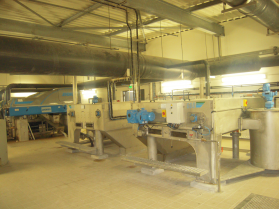drainability tests
Reading time:selecting a polymer for sludge flocculation
These tests are used to select a polymer for the following applications:
- dynamic thickening using the GDD screen, the GDE6 screen or the GDE8 screen (see liquid sludge treatment);
- dewatering using a belt filter, a centrifuge or a filter press (see liquid sludge treatment).
In both cases, the choice of flocculent is extremely important as it governs the filtration capacity and the sediment dry solids content.
There are three possible methods; the availability of the following equipment is compulsory in each case:
- a series of flocculent samples prepared with a 1 g· L-1 concentration for powder polyelectrolytes and a 2 mL· L-1 concentration for emulsion polyelectrolytes.
- a set of 1L beakers;
- a stopwatch.
büchner drainability test
This is the preferred test used to determine the best flocculent applied for filtration (drainage – belt filter – filter press).
equipment used
- 1 Büchner;
- 1 250 mL filtration test tube with side short tube;
- rapid paper filter;
- 1 regulated vacuum pump capable of creating a 0.5 bar vacuum.
operating procedure
- place a 200 mL sample of sludge into each numbered beaker;
- add different flocculating agents into each beaker, stirring manually and vigorously with a broad spatula until the formation of distinct floc (Ø > 3 mm) that is easily distinguished from the interstitial water obtained;
- record the amount of flocculent injected and check that an excess of flocculent does not induce any changes with the flocs;
- for the purpose of the Büchner, measurement select the beakers where sludge flocculation required the lowest flocculent dose.
measurement
With the apparatus assembled as illustrated in photo 7:
- set a 0.5 bar vacuum by closing the Büchner cell with a large rubber stopper;
- pour the sample of flocculated sludge on to the filter paper at once;
- start the stopwatch once 50 mL has been collected;
- stop the stopwatch after 150 mL of filtrate has been collected, i.e. «t» seconds.
The polyelectrolytes that should be selected for industrial trials are those that produced the shortest time “t” (fastest to drain) for which the interstitial water is the least viscous.
drainability test with GDD – GDE6 – GDE8 screens
This test does not require a vacuum pump but a sample of screens should be available:
GDD
(mesh size ranging from 350 to 600 µm) for biological liquor (2 to 8 g · L–1) or industrial sludge with a concentration below 10 g · L–1 (in this case, the use of an emulsion polyelectrolyte is mandatory),
GDE6
(600 µm mesh) for sludge having a concentration between 8 and 15 g· L-1,
GDE8
(800 µm mesh) for sludge having a concentration above 15 g· L-1,
A 500 mL sample of sludge is required for each test.
Once the Büchner drainability test (§ 6.9.1.) has been completed:
- flocculate the sludge;
- immediately pour all the flocculated sludge at the center of the screen;
- allow to drain for 2 minutes using a broad scraper to “roll” the sludge over the screen;
- determine the dry solids content of the drained sludge and collect the filtrate in a beaker;
- select the beakers that contain the most filtrate (series 1);
- carry out a second selection from series 1 based on the amount of dry matters deposited in the bottom of the beakers;
- isolate the beakers containing the least amount of solids (series 2). The most suitable flocculants are those from series 2.
The most suitable flocculants will be those in series 2.
industrial tests
tests using the GDD, GDE6 or GDE8
The flocculents selected should be tested via observation of the following parameters:
- draining rate;
- the mechanical strength of both the drained and flocculated sludge as it is moved with the scraper on the screen (good thickening properties, no destruction of flocs, good percentage recovery);
- flocculated and drained sludge adhesion to the screen (fouling capability).
The polymer selected is the one that best unites the following three conditions:
- fastest draining;
- best percentage recovery;
- lowest screen fouling over time.
The flocculating agents selected must be tested by observing the following for each:
belt filter test
Once the drainability test (§ 6.9.1.) is complete:
a) while the system is running, observe the feed sludge by the lower belt:
- case of Superpress: satisfactory floc separation on the flocculator discharge slope; quick draining, i.e. not much water at the surface of the sludge after the initial 50 centimetres of belt;
- case of the GDD + Superpress combination: the flocculated sludge at the GDD outlet should not look “too liquid”;
b) picket fence effectiveness: little water oozing when the sludge is com- pressed by the spreader roller; formation of a bead in front of the spreader roller; granular appearance of the floc (avoid big “fat” floc and very fine floc);
c) no lateral creep in the pressing zone;
d) sludge cake separates easily on delivery: cake has a “scaly” appearance and does not adhere much to the belts.
Bookmark tool
Click on the bookmark tool, highlight the last read paragraph to continue your reading later













